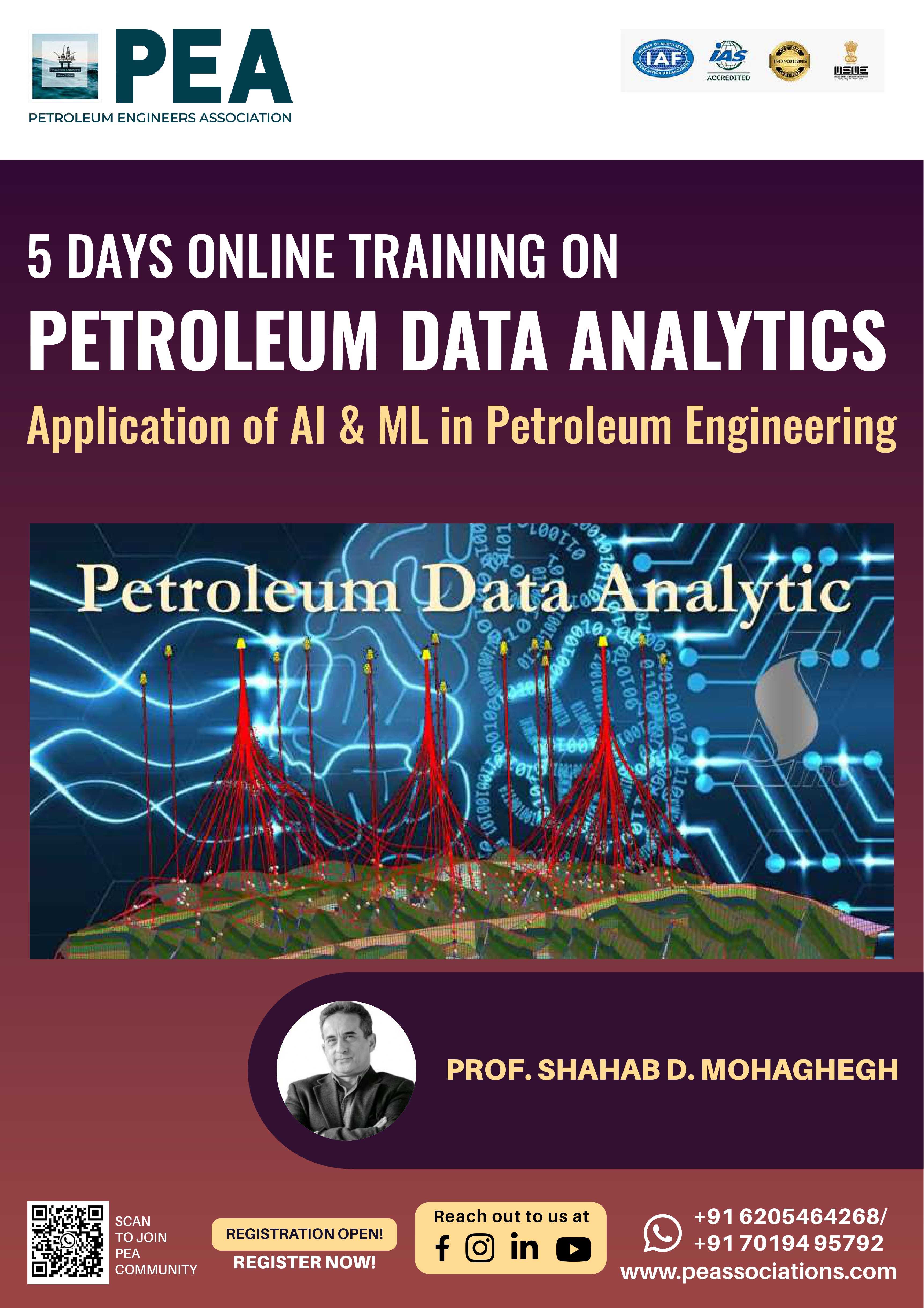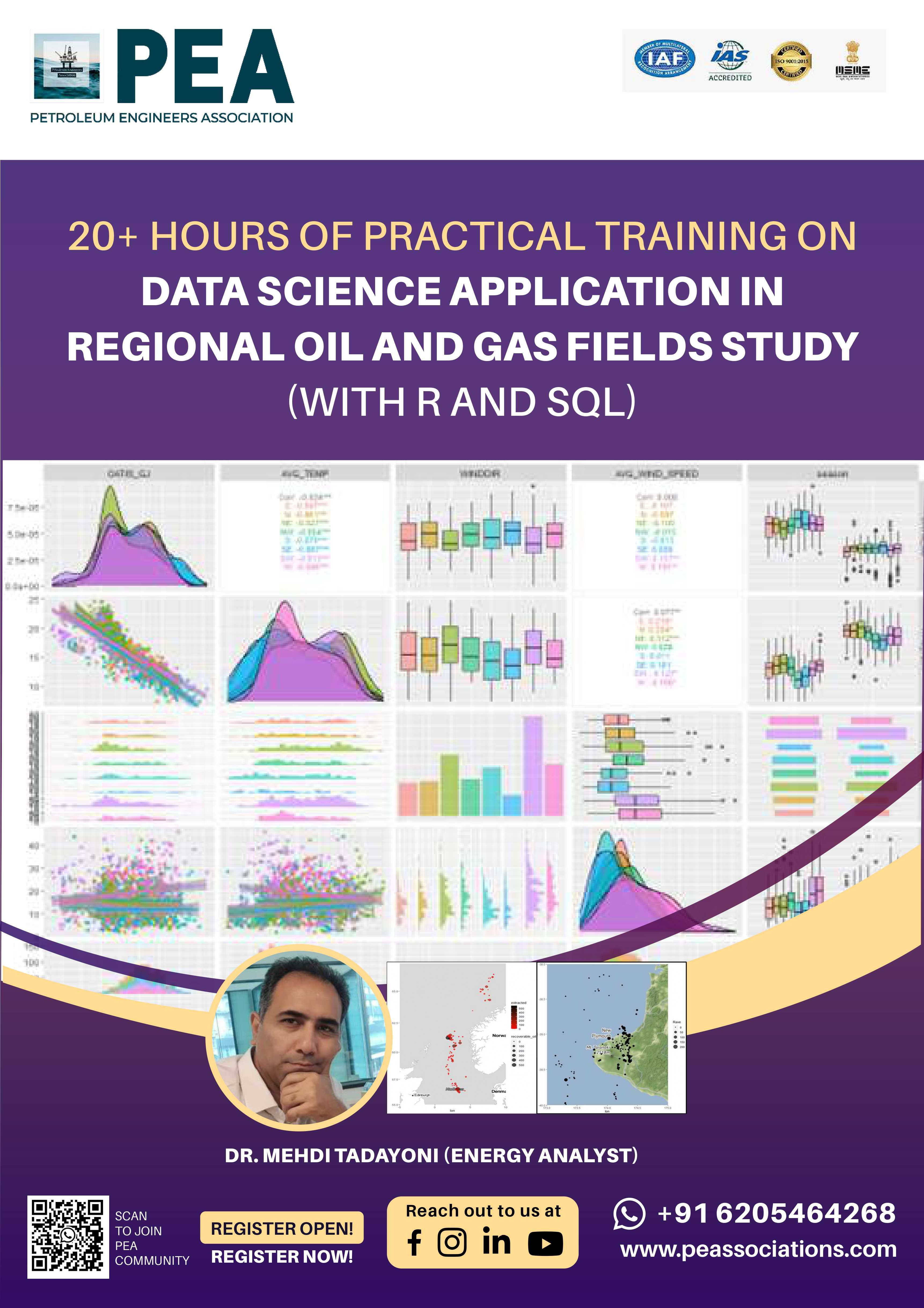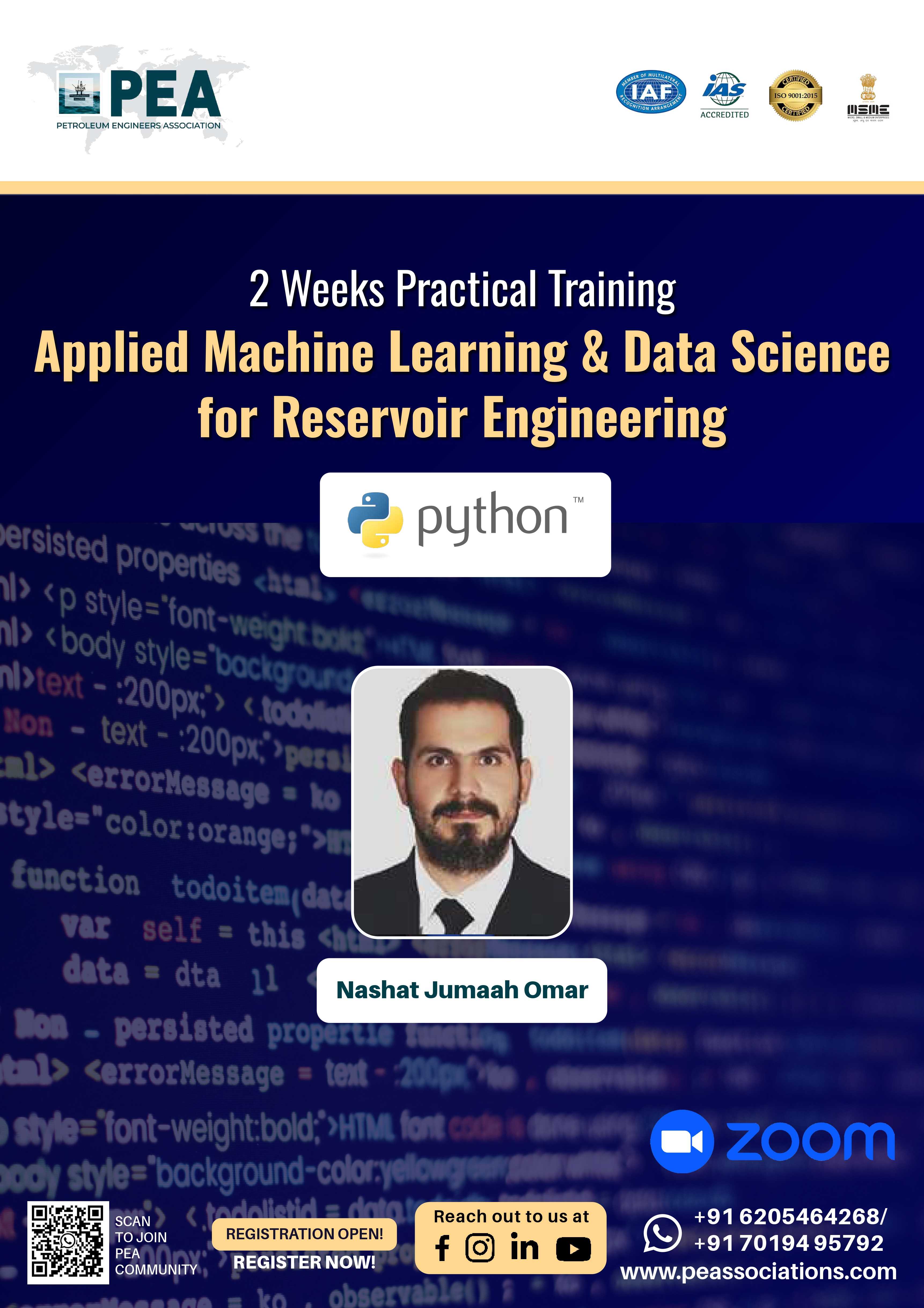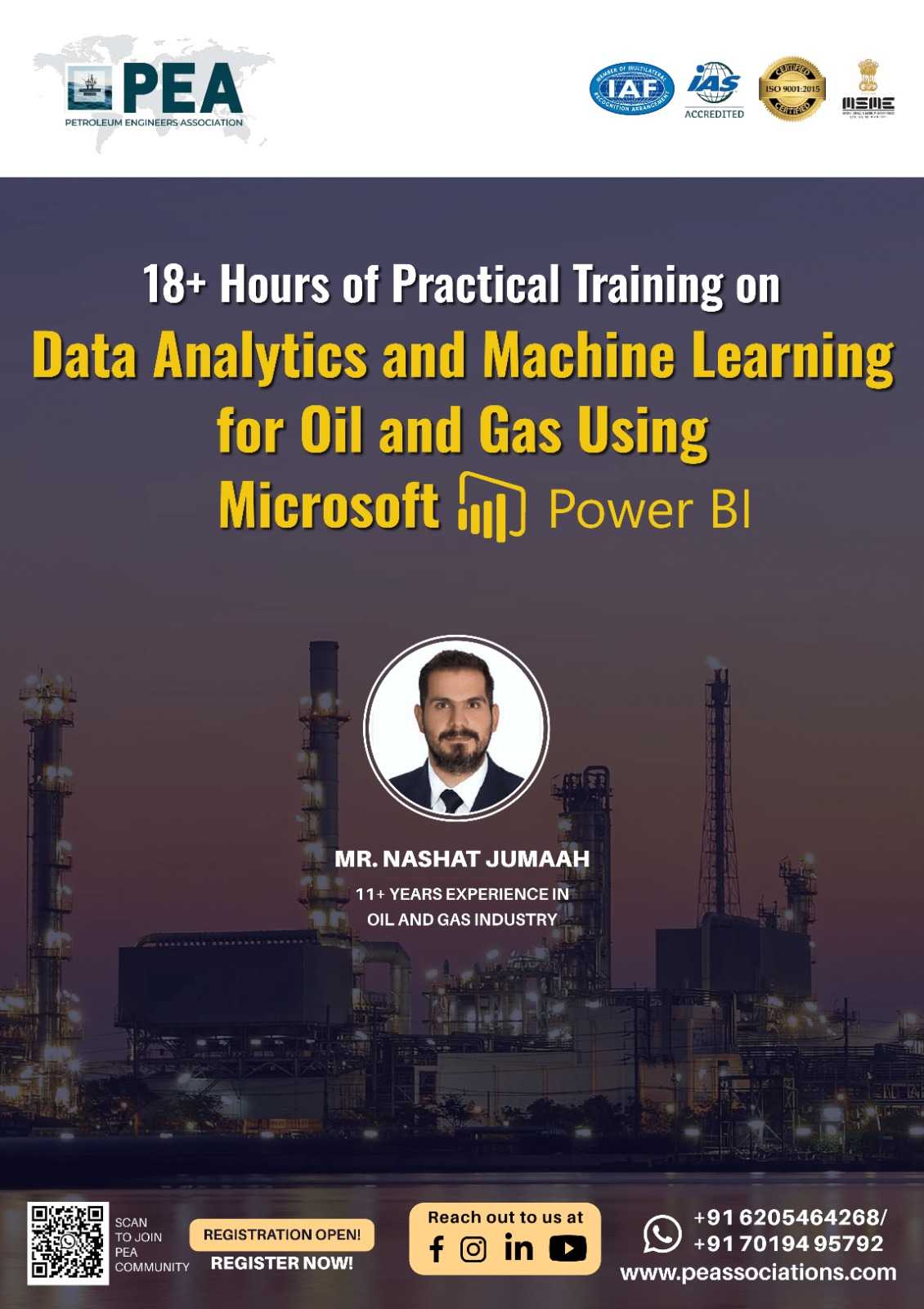| Code | Date | Time | Duration | Location | Currency | Team of 10 Per Person | Team of 7 Per Person | Early Bird Fee Per Person | Normal Fee Per Person |
|---|---|---|---|---|---|---|---|---|---|
| POG26 | 11 Apr - 31 May 2026 | 9 PM Indian Time |
2 Hours Per Day
|
Zoom Online
|
USD
|
1150
|
1250
|
1500
|
2500
|
The Classes Will be Only On Sat & Sun Via Zoom Online for 8 Weeks.
Boost your team's skills and your budget! Enjoy group discounts for collaborative learning. Send an inquiry to info@peassociations.com.
Python For Oil & Gas
Description
The “Python for Oil and Gas” course is tailored for professionals seeking to harness Python’s powerful capabilities within the oil and gas industry. From data analysis and automation to advanced visualization, this course equips participants with practical Python skills essential for today’s data-driven landscape. With a strong focus on real-world applications, attendees will work through hands-on exercises to enhance productivity, improve decision-making, and optimize engineering workflows.
Demo Class
The oil and gas industry is increasingly data-driven, and Python is a powerful tool for unlocking the insights hidden within complex datasets. This course is crafted specifically for professionals in the sector, providing them with the tools to automate tasks, analyze data more effectively, and make informed, data-driven decisions. With practical exercises and industry-focused examples, participants will gain the confidence to implement Python into their daily workflows.
Master Python fundamentals with a focus on industry-relevant applications.
Build robust data analysis and visualization skills tailored for oil and gas.
Learn automation techniques to enhance operational efficiency.
Develop advanced skills in data interpretation and reporting.
Apply Python to real-world oil and gas projects, improving decision-making.
This hands-on course includes interactive lectures, practical coding exercises, and project-based learning. Through real-life industry examples, participants will understand how to apply Python effectively to typical oil and gas scenarios.
Enhanced Productivity: Streamline complex tasks, reducing time and resources.
Informed Decision-Making: Leverage data insights to support critical operational decisions.
Increased Efficiency: Automate repetitive tasks, improving workflow and reducing manual errors.
Competitive Advantage: Equip teams with cutting-edge Python skills, staying ahead in a rapidly evolving industry.
Skill Development: Gain confidence in using Python for essential industry tasks.
Improved Problem-Solving: Apply data science techniques to real challenges.
Enhanced Career Opportunities: Strengthen your technical skills, adding a valuable asset to your professional profile.
Increased Efficiency: Improve your day-to-day productivity with practical coding skills.
Reservoir Engineers.
Production engineers.
Chemical engineers.
Drilling engineers.
Geologists and petrophysics
AL and workover engineer
Undergraduate students.
Module 1: (Day: 1 & 2)
·
Installing Anaconda Python Package
·
Introduction To Anaconda Software Packs
·
Introduction to Python Eco System
·
Why Python?
·
Basics expressions in python
·
Variables and Data Types
·
Sequences in Python (List, tuple, Set,
Dictionary)
·
Simple Plot with Matplotlib
·
Inflow Performance Example
Module 2 (Day: 3 & 4)
·
More on Sequences.
·
Programming Loops (For and While)
·
Integrated If statements and loops(Including
break, continue)
·
Introduction to Python Function(def keyword)
·
An Example on Recovery Factor(Guthrie Corr.)
·
A PVT Example
·
Exporting Plots
· Export Calculation results to Excel
Module 3 (Day: 5 & 6)
·
Introduction to Pandas
·
Reading Tabulated Data
·
Reading Excel Sheets
·
Historical Data Plotting
·
Introduction to JupyterLab
·
Plotting with Plotly Express
·
Liquid Loading (Turner’s Rate) Example
·
Chan Plot Diagnostic (with Polynomial
Regression)
·
Polynomial fitting using Numpy
·
Basic matplotlib figure configurations
Module 4 (Day: 7 & 8)
·
Introduction to matplotlib 2D Surface mapping
·
Contour Plots and it’s variants in Python
·
Oil Field Formation Depth Mapping Example
·
Water Oil Contact 3D mapping
·
Data Averaging using various techniques
utilizing Oil Production and WHP
·
Working with Las Files and Well logs using
Lasio.
Module 5 (Day : 9, 10)
·
Introduction to Plotly configuration
·
Plotly Subplots.
·
Introduction Sankey Charts.
·
An Example of Production Back Allocation
·
Creating Well and Separator Networks Visuals.
·
Introduction to two-phase multiphase flow
package(psapy)
·
Prediction of BHP using Beggs and Brill
Module 6 ( Day : 11 & 12)
·
Introduction To Flow mapping using fluids
package.
·
Multivariate scatter coloring and symbol setup.
·
Flow Stability Advisor Example.
·
NORSOK M-506 Corrosion Monitoring Example
·
Reading OLGA Trend Plots using Pyfas
·
Introduction to Dashboarding.
·
Working With Streamlit
Module (Day 7: 13 &14)
·
Creating Nodal Analysis Dashboard
·
Historical Production Data Dashboard
·
Recreating a PVT calculator using Dashbaords
·
Working with DCA (Simple time-rate solution)
Module 8 (Day: 15 & 16)
·
Introduction to Objected Oriented Python
·
Producing Clean Code.
·
Tips and Tricks for code maintenance and
refactoring
·
Introduction to Machine Learning
·
Data Shaping and Normalization
·
Training Testing Split.
·
Regressions and Output prediction.
·
Classification problems with Machine Learning.
·
Creating Production prediction using ML
· Multivariate regression.
On successful completion of this training course, PEA Certificate will be awarded to the delegates

Mr. Nashat J. Omar With over 11 years of specialized experience in petroleum engineering, focus on production and flow assurance brings valuable expertise to the energy sector.
He possess a strong command of Python and C#, which empowers him to create efficient data management solutions and streamline workflows.
His collaborative nature and adaptability enable him to thrive in multidisciplinary settings, where he consistently contributes to success through innovative problem-solving.
He is dedicated to continuous learning and staying ahead of industry advancements, ensuring that he can enhance operational efficiency and guarantee robust flow assurance.


























